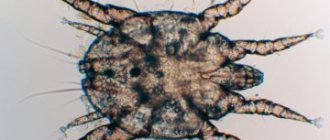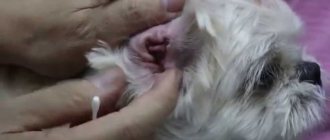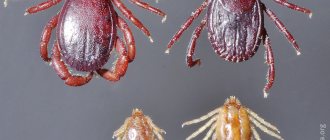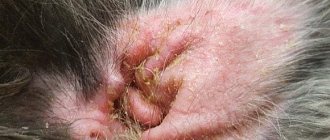What is an ear mite
What does a parasite look like? This is a very small insect, not reaching one millimeter, with a greyish-white translucent body, with a gnawing mouthpart. It gnaws through the skin and makes passages under it, laying eggs in them.
Ear mites under a microscope
The wounds become inflamed and fester. The larvae, feeding on the products of suppuration and lymphatic fluid, reach sexual maturity after 3-4 weeks, and then also lay eggs. In a short period of time, an ear mite can damage not only the skin of a dog’s ear, but also the eardrum, and further penetrate into the inner ear and brain.
The disease develops unnoticed - when the animal begins to show signs of the presence of a tick, then, as a rule, a significant part of the ear is affected. In addition, it was noted that the activity of the insect is subject to some cyclicity: a period of activity and bright symptoms is replaced by more or less calm intervals. This may be due to the cyclical development of the parasite. When pathology takes on threatening forms, there are no periods of rest.
How can a dog become infected with ear mites?
Ear mites can be transmitted from one animal to another, regardless of what stage of development it is at. During itching, the dog intensively scratches its ears, contributing to the spread of the parasite throughout the entire surface of the body. That is, the tick and its transitional forms can be located anywhere the pet is.
A healthy animal can “catch” ear mites in the following ways:
- upon contact (even fleeting) with a carrier animal;
- through a grooming item used by an infected dog;
- from a person who had contact with an affected representative;
- through fleas (they can carry tick larvae);
- from the mother (in puppyhood).
Symptoms of ear mites
You can suspect ear mites in a dog if you find a dirty brown mass in the external auditory canal. It is formed from skin scales, particles of the outer integument of shed parasites, and the secretion of the ear glands. All this is mixed with purulent discharge from damaged areas of the epidermis and mite excrement, and leads to severe skin irritation and an inflammatory process.
Other ear mite symptoms:
- hyperemia of the skin of the ear canal;
- severe itching;
- swelling of the ear folds.
The dog is nervous, shakes its head, and often itches. When scratching or shaking the ears, particles of accumulated mass may fly out of the external auditory canal.
How to tell if your dog has ear mites
Ear mites (or otodectosis) is a disease caused by the activity of microscopic parasites. They “occupy” the external auditory canal and the inner surface of the ear. Ticks damage the skin by breaking through passages. They feed on lymph, sulfur and blood. Parasites not only feed, but also reproduce in the ears. Over time, their waste products form a brown substance that is easily confused with dirt.
To recognize ear mites, you need to inspect your ears regularly. If they are covered with scratches, and a dark “mush” has accumulated in the ears, this is otodectosis. Sometimes the signs are invisible, and ear mites can only be detected in a laboratory setting.
How are ear mites transmitted?
Any dog can become infected with parasites. They are transmitted through contact with infected animals, most often stray dogs. Even the owner can bring ticks: they “travel” on hands and clothes. Cats are especially susceptible to infection, so contact with “strays” should not be allowed.
Otodectosis is not transmitted to humans, but people can be carriers. In order not to harm your pet, you need to wash your hands after a walk and do not pet stray animals.
Diagnostics
Diagnosing ear mites in dogs is not difficult: during the examination, the veterinarian will take material from the ear and look at it under a microscope. In the chronic form, bacterial seeding of the contents of the ear canal may be required to determine the sensitivity of the insect to drugs and to select the optimal drug. In advanced cases, a specialist may prescribe an X-ray examination or computed tomography to identify the condition of the inner ear and membranes of the brain. Additional diagnostic procedures include: bacterial analysis, scrapings, and allergy tests.
How do dogs become infected with ticks?
Ticks can live not only on dogs' bodies, but also in their ears. They bring them significant discomfort and in some cases can cause serious illness and even lead to the death of the animal. Therefore, parasites that have settled in your pet’s ears should never be ignored. Many owners will find it useful to know what otodectosis (ear mites) is in dogs, about the routes of infection by these parasites and their manifestations, as well as about the diagnostic procedures prescribed in veterinary clinics to detect the disease and methods of treating it.
Ear mites are small, crab-shaped, transparent arachnids belonging to the genus Otodectes. They settle primarily in the canals of dogs' ears, but can sometimes spread to the head and body. Parasites feed on dead skin cells of animals and their tissue fluids. To find food, they gnaw through the epidermis on the inner surface of dog ears and make many moves in it. Females lay eggs in them, from which larvae subsequently hatch . They grow to adulthood very quickly - in just a month.
As mites multiply, they cause a disease called otodectosis or ear scabies. Most often, domestic cats suffer from it, dogs - a little less often. The latter can catch ticks when:
- come into contact with other dogs or cats, both domestic and stray;
- walk in nature: on a dog park, in the country or in the forest.
Ticks also get onto a pet’s body from people’s clothes and shoes, so even the dog’s owner himself or other owners with whom the animal communicates can become possible carriers of parasites. In the same way, those four-legged animals that never go outside become infected.
Otodectosis can affect dogs of both sexes and different ages, but in most cases the disease affects small puppies. They get ticks from their sick mother.
Is it possible to identify ear mites yourself at home?
There are situations when it is not possible to conduct a microscopic examination of a dog in a clinic. Before treating your pet for otodectosis, you can independently identify the parasite at home. To do this you will need a cotton swab, a piece of dark paper and a magnifying glass. Taking a small amount of plaque from your pet’s external auditory canal with a stick, you need to apply it to paper. If the disease is present, under a magnifying glass you can see moving ticks of a light gray hue.
Important: at the initial stages of pathology development, the population may be small. Therefore, the likelihood that the collected material will contain insects is reduced.
How to treat ear mites in dogs
It can be difficult to treat otodectosis and requires treatment with antiparasitic drugs. In severe cases of the disease, more than one course will be needed to completely get rid of the pathology.
Medicine for ear mites for external use is applied only to clean areas of the epidermis. Therefore, impurities are removed from the skin.
Scabs accumulated in the ears are first softened with hydrogen peroxide, boric acid, lotion or other antiseptic agents. Next, they are carefully removed and the drug is applied.
In most cases, acaricidal treatment is carried out twice, depending on the life cycle of the tick.
Insecticidal preparations are toxic, so they are used strictly according to the instructions in compliance with the prescribed dosages. If adverse reactions occur in the animal, the medication is discontinued.
Drops
This form of release of the drug is convenient to use and it is easy to measure the required dosage. In the treatment of otodectosis, ear drops are most often used:
- Decta. Complex remedy against various types of ticks. Destroys parasites at any stage of development by destroying the nervous system of the arthropod. The antibiotic included in the composition fights infection in areas of injury to the skin. Propolis suppresses inflammation, has analgesic and antimicrobial properties. Place 3-5 drops of medicine into each ear and massage lightly. Compliance with this measure guarantees the absence of toxicity. Not suitable for pregnant bitches and puppies up to one month old.
- Anandin Plus. Effective for ear scabies complicated by otitis media in dogs. Contains the acaricide permethrin, the antibiotic gramicidin and the antihistamine glucaminopropylcarbacridone. Destroys parasites, inhibits the growth of pathogenic microflora and relieves inflammation in the ear.
For the treatment of otodectosis, drops of Stronghold, Frontline Spot-On, Ear-Mite Treatment, Tresaderm, Fiprist Spot-On, Tsipam, Otovedin, Advocate, Inspector for dogs are also used.
Ointments, gels and emulsions
They have a thick texture, soft and long-lasting action. Effective against otodectosis:
- Sulfur-tar ointment. Intended for external application to areas affected by ticks. Apply a thin layer and rub in a little. Apply twice a day until complete relief from otodectosis (on average 7-10 days). The drug destroys the pest and suppresses the pathogenic activity of microorganisms. Safe for dogs of all ages, no contraindications.
- Birch tar. It has an insecticidal effect, heals injured skin, and destroys pathogenic microorganisms. To treat the skin, take a warm ointment heated to 40 degrees. Apply twice a day. The course of treatment is twice with a break of one week.
- Amidel-gel. Contact action acaricidal agent. Provokes severe stimulation of ticks, leading to death. It has a powerful analgesic and wound healing effect. The dosage is half a milliliter of medicine per kilogram of animal weight. Contraindicated in pregnant females, puppies up to two months old, dogs susceptible to infectious pathologies and exhaustion.
In addition to ointments, Epacid Alfa and Butox 50 emulsions are used to treat the affected ear. For complicated otodectosis, Oridermil is used.
Sprays
The advantage of this form is uniform spraying in the affected area. Quickly and conveniently process large areas. Shake the aerosol can before each use. For medicinal purposes the following is prescribed:
- Acrosol. An effective contact action product intended for the treatment of otodectosis. Sprays onto the desired area within one second. For deeper penetration of the drug components, the ear is bent and lightly massaged. Process twice, with a break of one week. It is forbidden to use puppies up to a month old.
- Frontline. Insectoacaricidal drug against various types of fleas, ticks, lice eaters. Destroys both adult insects and their larvae. Due to the oily components, it remains on the skin for a long time, preventing re-infection.
Sprays are sprayed at a distance of ten centimeters from the lesion. Treatment is carried out outdoors or in a ventilated area.
Solutions for injections
If the dog does not have certain restrictions on the use of injection solutions, it is recommended to use this type of therapy.
Tick control agents in the form of injections cope not only with external pests, but also destroy internal parasites. They have a longer lasting effect than medications for external treatment. In veterinary medicine they use:
- Otodectin. An antiparasitic drug aimed at eliminating external and internal pests at any phase of development. The dosage for dogs is calculated as 0.2 milliliters of medicinal solution per kilogram of weight. It is effective for two weeks and is completely excreted in urine. Injections are recommended to be given in the shoulder blade or forearm.
- Ivermek 1%. Systemic solution. The active substance leads to paralysis and subsequent death of external, ocular, and gastrointestinal parasites. Active in the animal’s body for 10-14 days. Use once, administered intramuscularly. The maximum dosage is 0.2 milliliters per 10 kilograms of weight.
- Aversect 0.5%. It is administered twice with a break between injections of 1-1.5 weeks.
The last two drugs are contraindicated for use in Sheltie and Collie breeds.
Folk remedies
Therapy at home rarely leads to recovery of the dog. It is impossible to remove ticks using folk remedies alone. However, this method is a good addition to the main treatment prescribed by the doctor. Particularly effective at the initial stage of otodectosis.
To treat a dog’s ear affected by ticks, the following recipes are suitable:
- Strongly brewed black tea without additives or flavorings.
- Sunflower oil with one part iodine solution.
- Kerosene mixed with olive oil in equal proportions.
Traditional methods have a number of advantages:
- natural composition;
- no toxicity;
- there are no side effects or contraindications, with the exception of hypersensitivity to the components of the substance.
Herbal medicines relieve symptoms and speed up recovery.
How to prepare a dog's ear for treatment
Before instilling ear mite drops, you need to clear your pet's ears of any accumulated mass. If the dog resists (not all animals tolerate this procedure stoically, especially if they experience pain), it is better to carry out the procedure together. For small sizes, you can throw a blanket over it or wrap it in a towel. If the pet is large, you should use a muzzle.
During the cleaning process, you must adhere to the following recommendations.
- You need to use sticks, not cotton swabs or disks, as there is a risk of pushing the accumulated mass deeper into the ear canal.
- You should start cleaning from areas located close to the edges of the ear, gradually moving deeper.
- The movements of the wand should be outward.
- If the masses are dry, you can wet the cotton end with peroxide or chlorhexidine. You can't put them in your ear.
- It is advisable to use lotions specifically designed for this purpose to clean your ears.
- If your dog has long hair growing on his ears, it will need to be cut off during treatment.
Veterinary remedies for ear mites
Drops in the ears "Anandin"After cleaning the ears, 3-5 drops of the drug (depending on the size of the dog) are instilled into each ear, even if only one is affected. Drops are used once a day for 4-7 days until the discharge disappears. The price of the drug is 55 rubles. |
Drops against ear mites "Amitrazine"1-2 ml of medication is instilled into each ear. Repeated injections are made once every 3 days until complete recovery. The cost is about 70 rubles. |
Drops "Bars"3-5 drops are instilled into two ears, repeated after 5-7 days. Price 95 rubles. |
Ivermec gelA 0.5-2 cm strip of gel is applied deep into the ear canal (in both ears) and massaged thoroughly. Treatment is carried out twice with a break of 5-7 days. The price of a 30 ml tube is 400 rubles. |
OtovedinThis medicine for ticks is also instilled into both ears of the dog, 3-5 drops, twice with an interval of 5-7 days. The price of the bottle is 40 rubles. |
Tsipam3-6 drops in each ear with an interval of 5-7 days. Price 140 rubles. |
Prevention
It is impossible to completely prevent your pet from becoming infected with ear mites. However, with the help of preventive measures, you can reduce the likelihood of developing the disease. To do this you need:
- do not allow the dog to come into contact with unfamiliar relatives;
- periodically carefully examine the animal;
- If you find brown plaque in your four-legged friend’s ears, visit the clinic as soon as possible and undergo an examination;
- periodically carry out preventive cleaning with special preparations, which are selected together with a veterinarian, taking into account contraindications and other nuances.
The disease has a favorable prognosis if detected early and treated correctly. At the very beginning of the development of otodectosis, it happens that the ear mites disappear after one cleansing procedure and use of the drug. In advanced cases, you need to be patient, follow the rules of hygiene for your pet’s ears, adhere to the treatment regimen, and increase the dog’s immunity.
Prevention measures and means
Prevention is the key to animal health. To avoid having to eliminate the consequences of infection, you need to stick to a simple plan:
- Avoid contact with stray animals.
- Carry out regular ear examinations. Brown sediment may be a symptom of otodectosis.
- Timely ear cleaning. You can prevent the development of the disease by promptly removing parasites.
- During the tick season, you need to use preventive measures: anti-tick collars (Beafar, Foresto, Kiltix, Bars), drops on the withers (Stronghold, Frontline), tablets (Bravecto).
Ear mites are easily curable at the initial stage. Ignoring symptoms can lead to the development of infections and complications. The owner must provide the dog with timely medical care. This will allow your pet to live a long and happy life.











